Welcome back to another instalment of Clearview Blog. Over the next several weeks, we’ll be examining machine vision frame grabbers and the varying interfaces that they use.
To begin with, we’ll be outlining peripheral computer cards, and then exploring the different types of machine vision interfaces used in frame grabbers.
Let’s start with a commonly-asked question: what are peripheral computer cards, and how can we categorise them?
Frame Grabbers, NICs and Host Adapters for Machine Vision
Peripheral machine vision computing cards tend to come in three main categories: host adapters, NICs, and frame grabbers.
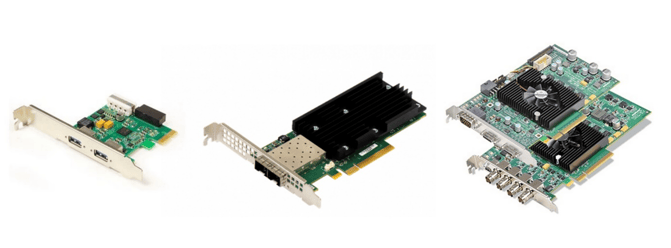
Left to right: Host adapter, NIC, Frame Grabber
Host adapters, simply put, expand the function of a host PC by granting extra ports. Anything can be connected and used, as long as the right drivers are installed. Installing host adapter cards can be a cost-effective way to broaden the interfacing capabilities of your host PC without having to spend on a new industrial PC. However, host adapters will only take you so far – they do not increase the PC’s performance, or provide any processing capabilities.
NICs, or network interface cards, are computer expansion cards that enable a PC to connect to a network, and can provide extra processing power depending on the card. For example, if your project entails imaging in one area, and processing these images in another area, this can be done using NICs across a local network, usually with an Ethernet cable sporting an RJ-45 connector.
Frame grabbers, on the other hand, are peripheral cards designed specifically for imaging.
Frame grabbers are machine vision hardware cards that capture, or ‘grab’, individual still frames from a video stream. These frames can then be processed using different machine vision algorithms depending on the application.
Frame Grabber expansion cards used to be the primary method of connecting cameras with computer systems. Since then, the technology has become more streamlined, with Frame Grabbers interfacing with PCs with interfaces such as USB Vision, GigE Vision, and CoaXPress.
These main interfaces have come to form a revolutionary set of standards in machine vision known as GenICam, the bedrock of modern machine vision technology.

GenICam
There are several machine vision standards for interfaces, but none are as important to machine vision as GenICam. A portmanteau of ‘Generic Camera Interface’, GenICam was officially created in 2006, and sought to unite camera interfaces, PC hardware support, and software compatibility under one roof.
This is what we now know as ‘plug-and-play’ functionality – the ability to take a camera from manufacturer A, plug it into a computer from manufacturer B, using a cable produced by manufacturer C, and run machine algorithms developed by manufacturer D – and have it all run smoothly with no hitches, provided all the hardware and software used comply with the GenICam standard.
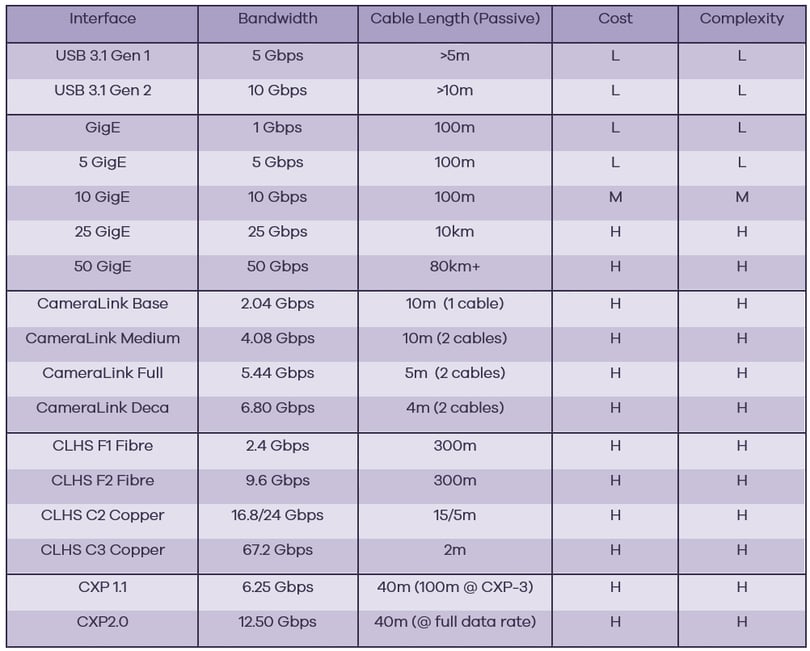
GigE Vision
Launched alongside GenICam in 2006, GigE Vision utilizes ethernet-style ports, is relatively cheap, and is commonplace in machine vision systems. A GigE vision camera can be connected to the host PC with cable lengths of up to 100 meters and will still be able to deliver reliable imaging, which makes it a good contender for sports broadcasting and other applications where long cables are required.
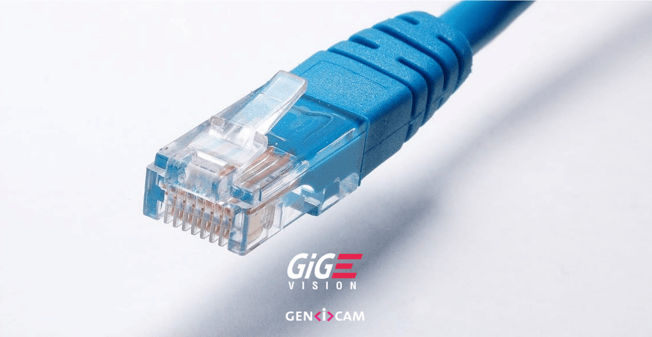
The number in front of GigE denotes that particular platform’s bandwidth. Standard GigE (or ‘1GigE’) is capable of 1Gbps data transfer speeds. This means that 5GigE and 10GigE bandwidths are capable of 5Gbps and 10Gbps transfer speeds respectively.
New GigE Technology
With the launch of LUCID’s new GigE platforms comes a real revolution in choice. The power users now get 25GigE, a platform capable of delivering stable images to a computer system up to 10 kilometers away, using advanced cabling technologies built with SFP28 fiber cables and step-up transceivers.
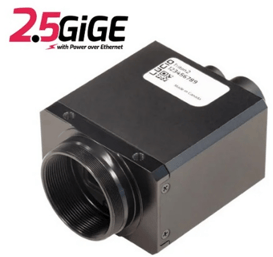
Users struggling with the limitations of 1GigE that don’t want the size and cost of 5GigE or 10GigE can opt for the new Triton2.5, the world’s first 2.5GigE camera.
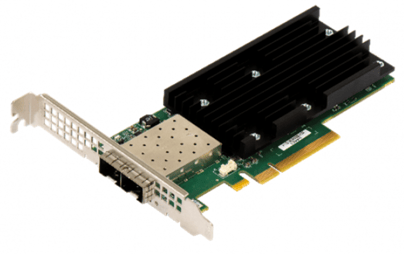
For more on hardware advancements with GigE and other technologies, check out our previous blog post.
USB Vision
Just as popular on account of its low cost and innate compatibility with virtually every computer system under the sun, USB Vision is widely used in machine vision systems everywhere.
USB3 Vision has evolved rapidly since entering usage in machine vision. USB 3.0 at launch was capable of 5 Gb/s in 2013. This was followed up two years later with USB 3.1, which could handle 10 Gb/s – and subsequently in 2017, USB 3.2 offered up 20 Gb/s with the addition of multiple data lanes.
Teledyne FLIR offer a really solid selection of frame grabbers in the latest USB3 Vision format. Check out our frame grabbers page for more info.
CoaXPress
CoaXPress is a great alternative option to GigE and USB vision. It relies on a simple coaxial interface, capable of delivering 6.25 Gbps per cable, while the newer CoaXPress 2.0 iteration has transfer speeds of 12.5 Gbps per cable.
Power over cable is also available with this interface, simplifying complexity and negating the need to run additional power cables around your project. This is perfect for systems that require compactness and logistical simplicity, such as automated vehicles. CoaXPress is also a low latency, low noise interface, which is critical in automated vehicle applications.
Furthermore, with CoaXPress it is possible to run multiple cameras through one frame grabber – meaning there’s no end to the potential scalability with this platform.
Matrox’s Rapixo CXP frame grabber is a good choice here as a cost-effective solution on the CoaXPress platform with high performance.
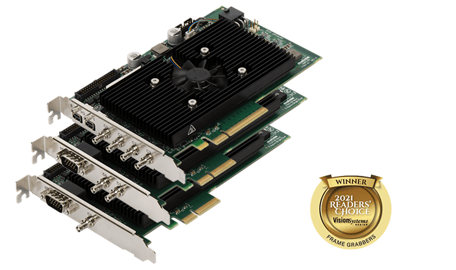
CameraLink
CameraLink, like the above machine vision interface standards, was born in 2000 following the frustration in the 1990s of designing bespoke cables for each and every possible LVDS combination of cameras and frame grabbers.
Whilst the complexity of CoaXPress and CameraLink cables is slightly more than GigE and USBVision, there are definitely advantages to these platforms. CameraLink has a range of different individual interface types that span varying bandwidths, cable lengths and price points, and there are many, many options when it comes to frame grabbers – leading the charge here are industry favorites Matrox Imaging, who offer some robust choices in the Camera Link interface.

Camera Link HS
CameraLink HS – standing for High Speed – offer truly impressive bandwidths able to compete with 2.5GigE and 10GigE platforms in their F1 Fiber (2.4 Gbps) and F2 Fiber (9.6Gbps) iterations, and even completely outperform GigE in the C3 Copper option, able to deliver up to a whopping 67.2 Gbps.
A Wide World of Machine Vision Frame Grabbers
These four main interface options cover an impressive breadth of options suitable for all types of machine vision application.
Stay tuned with this series as we explore these formats in greater detail, bringing you the machine vision expertise and knowledge to help make the right decisions for your machine vision system.
Future Focused Vision Systems from Clearview
Want to find out more about revamping a vision system or automating industrial processes? Look no further – get in touch with us.




